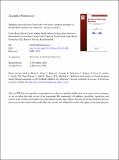Synthesis and evaluation of frentizole-based indolyl thiourea analogues as MAO/ABAD inhibitors for Alzheimer’s disease treatment
Abstract
Alzheimer’s disease (AD) is a neurodegenerative disorder associated with an excessive accumulation of amyloid-beta peptide (Aβ). Based on the multifactorial nature of AD, preparation of multi-target-directed ligands presents a viable option to address more pathological events at one time. A novel class of asymmetrical disubstituted indolyl thioureas have been designed and synthesized to interact with monoamine oxidase (MAO) and/or amyloid-binding alcohol dehydrogenase (ABAD). The design combines the features of known MAO inhibitors scaffolds (e.g. rasagiline or ladostigil) and a frentizole moiety with potential to interact with ABAD. Evaluation against MAO identified several compounds that inhibited in the low to moderate micromolar range. The most promising compound ( 19 ) inhibited human MAO-A and MAOB with IC50 values of 6.34 μM and 0.30 μM, respectively. ABAD activity evaluation did not show any highly potent compound, but the compound series allowed identification of structural features to assist the future development of ABAD inhibitors. Finally, several of the compounds were found to be potent inhibitors of horseradish peroxidase (HRP), preventing the use of the Amplex™ Red assay to detect hydrogen peroxide produced by MAO, highlighting the need for serious precautions when using an enzyme-coupled assay.
Citation
Hroch , L , Guest , P , Benek , O , Soukup , O , Janockova , J , Dolezal , R , Kuca , K , Aitken , L , Smith , T K , Gunn-Moore , F , Zala , D , Ramsay , R R & Musilek , K 2017 , ' Synthesis and evaluation of frentizole-based indolyl thiourea analogues as MAO/ABAD inhibitors for Alzheimer’s disease treatment ' , Bioorganic & Medicinal Chemistry , vol. 25 , no. 3 , pp. 1143-1152 . https://doi.org/10.1016/j.bmc.2016.12.029
Publication
Bioorganic & Medicinal Chemistry
Status
Peer reviewed
ISSN
0968-0896Type
Journal article
Description
This work was supported by the Ministry of Health of the Czech Republic (no. NV15-28967A), the Charles University in Prague (SVV 260 291), COST Action CM1103 (STSM 15879 and 17487) and CA15135, University of Hradec Kralove (Faculty of Informatics and Management, project Excellence 2015), University of St Andrews (undergraduate project funding to D.Z.), Biotechnology and Biological Sciences Research Council (BBSRC; no. BB/J01446X/1), the Alzheimer’s Society and the Barcopel Foundation.Collections
Items in the St Andrews Research Repository are protected by copyright, with all rights reserved, unless otherwise indicated.

